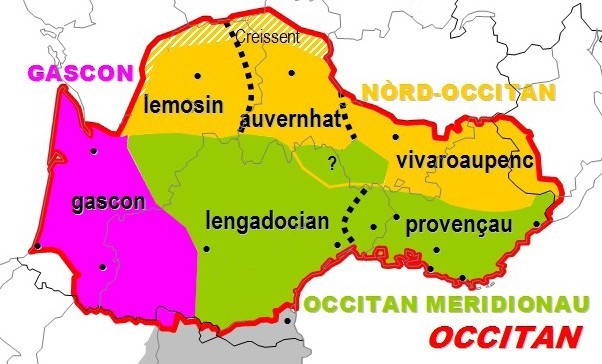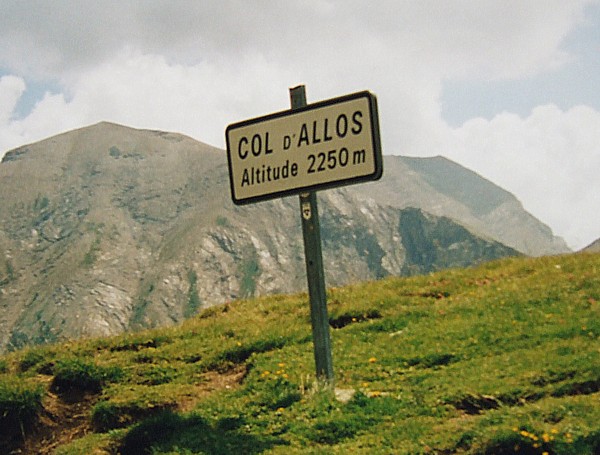|
Vivaro-Alpine
Vivaro-Alpine ( oc, vivaroalpenc, vivaroaupenc) is a variety of Occitan spoken in southeastern France (namely, around the Dauphiné area) and northwestern Italy (the Occitan Valleys of Piedmont and Liguria). There is also a small Vivaro-Alpine enclave in the Guardia Piemontese, Calabria, where the language is known as ''gardiòl''. It belongs to the Northern Occitan dialect bloc, along with Auvergnat and Limousin. The name “vivaro-alpine” was coined by Pierre Bec in the 1970s. The Vivaro-Alpine dialects are traditionally called "gavot" from the Maritime Alps to the Hautes-Alpes. Naming and classification ''Vivaro-Alpine'' had been considered as a sub-dialect of Provençal, and named ''provençal alpin'' (Alpine Provençal) or Northern Provençal. Its use in the Dauphiné area has also led to the use of ''dauphinois'' or ''dauphinois alpin'' to name it. Jules Ronjat, ''Grammaire istorique des parlers provençaux modernes, vol. IV Les dialectes'', Montpellier, 1941 Along ... [...More Info...] [...Related Items...] OR: [Wikipedia] [Google] [Baidu] |
Occitan Language
Occitan (; oc, occitan, link=no ), also known as ''lenga d'òc'' (; french: langue d'oc) by its native speakers, and sometimes also referred to as ''Provençal'', is a Romance language spoken in Southern France, Monaco, Italy's Occitan Valleys, as well as Spain's Val d'Aran; collectively, these regions are sometimes referred to as Occitània. It is also spoken in Calabria ( Southern Italy) in a linguistic enclave of Cosenza area (mostly Guardia Piemontese). Some include Catalan in Occitan, as the distance between this language and some Occitan dialects (such as the Gascon language) is similar to the distance between different Occitan dialects. Catalan was considered a dialect of Occitan until the end of the 19th century and still today remains its closest relative. Occitan is an official language of Catalonia, where a subdialect of Gascon known as Aranese is spoken in the Val d'Aran. Since September 2010, the Parliament of Catalonia has considered Aranese Occitan to ... [...More Info...] [...Related Items...] OR: [Wikipedia] [Google] [Baidu] |
Auvergnat
or (endonym: ) is a northern dialect of Occitan spoken in central and southern France, in particular in the former administrative region of Auvergne. Currently, research shows that there is not really a true Auvergnat dialect but rather a vast northern Occitan linguistic area. The word "Auvergnat" is above all a local historiographical creation. According to linguist Jean Roux, "It is by simplification that we use this term, because in no case Auvergnat can be considered as an autonomous linguistic entity". With around 80,000 speakers in the Auvergne region at the beginning of the 21st century, it is considered to be severely endangered. Classification Auvergnat falls under the following categories and subcategories: Indo-European, Italic, Romance, Italo-Western, Gallo-Iberian, Gallo-Romance, Occitan. History Several troubadours were from the Auvergne, including Castelloza, Dalfi d'Alvernhe, the Monje de Montaudon, the Vesques de Clarmon, Peire d'Alvernhe, Peire Ro ... [...More Info...] [...Related Items...] OR: [Wikipedia] [Google] [Baidu] |
Mentonasc Dialect
Mentonasc (; Mentonasco in Italian, Mentonnais or Mentonasque in French) is a Romance dialect historically spoken in and around Menton, France. It is classified as a dialect of Occitan and a sub-dialect of Vivaro-Alpine, with some strong influence from the neighbouring Intemelian Ligurian dialect spoken from Ventimiglia to San Remo. Classification Mentonasc is considered to be a transitional language; it is an intermediate language between Occitan and Ligurian, which is why the classification of Mentonasc is often debated. However, it is traditionally assigned to the Occitan language by French scholars and to Ligurian dialects by Italian scholars. The Mentonasc dialect bears strong similarities with the common alpine dialects, such as, Royasque or Pignasque. It differs quite significantly especially in the ear from Ligurian coastal dialects ( Northern Italian), like those of Ventimiglia ( Intemelio dialect) or Monaco (Monégasque dialect). History When the area of Mento ... [...More Info...] [...Related Items...] OR: [Wikipedia] [Google] [Baidu] |
Dauphiné
The Dauphiné (, ) is a former province in Southeastern France, whose area roughly corresponded to that of the present departments of Isère, Drôme and Hautes-Alpes. The Dauphiné was originally the Dauphiné of Viennois. In the 12th century, the local ruler Count Guigues IV of Albon (c. 1095–1142) bore a dolphin on his coat of arms and was nicknamed ''le Dauphin'' (French for dolphin). His descendants changed their title from Count of Albon to Dauphin of Viennois. The state took the name of Dauphiné. It became a state of the Holy Roman Empire in the 11th century. However, the Dauphin of France was the title of the eldest son of a king of France and the heir apparent to the French crown, from 1350 to 1830. The title was established by the royal house of France through the purchase of lands known as the Dauphiné in 1349 by the future Charles V of France. The Dauphiné is best known for its transfer from the last non-royal Dauphin (who had great debts and no direct h ... [...More Info...] [...Related Items...] OR: [Wikipedia] [Google] [Baidu] |
Provençal Dialect
Provençal (, , ; french: provençal , ; oc, provençau or ) is a Romance language, either considered as a variety of Occitan or a separate language, spoken by people in Provence and parts of Drôme. Historically, the term Provençal has been used to refer to the whole of the Occitan language, but today it is considered more technically appropriate to refer only to the variety of Occitan spoken in Provence. However it can still be found being used to refer to Occitan as a whole, ''e.g.'' Merriam-Webster states that it can be used to refer to general Occitan, though this is going out of use. Provençal is also the customary name given to the older version of the Occitan language used by the troubadours of medieval literature, when Old French or the ' was limited to the northern areas of France. Thus the ISO 639-3 code for Old Occitan is ro In 2007, all the ISO 639-3 codes for Occitan dialects, including rvfor Provençal, were retired and merged into ciOccitan. The old c ... [...More Info...] [...Related Items...] OR: [Wikipedia] [Google] [Baidu] |
Pierre Bec
Pierre Bec (; oc, Pèire Bèc; 11 December 1921 – 30 June 2014) was a French Occitan-language poet and linguist. Born in Paris, he spent his childhood in Comminges, where he learnt Occitan. He was deported to Germany between 1943 and 1945. After returning, he studied in Paris, where he graduated in 1959. He was one of the founders of the IEO or Institut d'Estudis Occitans (Institute of Occitan Studies) as well as its president from 1962 to 1980. Life Pierre Bec spent his childhood in Cazères-sur-Garonne where he learned Gascon. In 1938, he was an interpreter for the Spanish Republican refugees who had crossed the Pyrenees, and he discovered Catalan. He was deported in March 1943 to Germany as part of the compulsory labor service. Bec was titular professor at Poitiers university and assistant director of the ''Centre d'Études Supérieures de Civilisation Médiévale'' (Centre for high studies in medieval civilisation). He is considered one of the most important specialis ... [...More Info...] [...Related Items...] OR: [Wikipedia] [Google] [Baidu] |
Maritime Alps
The Maritime Alps (french: Alpes Maritimes ; it, Alpi Marittime ) are a mountain range in the southwestern part of the Alps. They form the border between the French region of Provence-Alpes-Côte d'Azur and the Italian regions of Piedmont and Liguria. They are the southernmost part of the Alps. Geography Administratively the range is divided between the Italian provinces of Cuneo and Imperia (eastern slopes) and the French department of Alpes-Maritimes (western slopes). The Maritime Alps are drained by the rivers Roya, Var and Verdon and their tributaries on the French side; by the Stura di Demonte and other tributaries of the Tanaro and Po on the Italian side. There are many attractive perched villages, such as Belvédère at the entrance to the spectacular Gordolasque valley, some concealing unexpected architectural riches (for example in the south there are numerous churches decorated with murals and altarpieces by primitive Niçois painters). Borders The borde ... [...More Info...] [...Related Items...] OR: [Wikipedia] [Google] [Baidu] |
Hautes-Alpes
Hautes-Alpes (; oc, Auts Aups; en, Upper Alps) is a department in the Provence-Alpes-Côte d'Azur region of Southeastern France. It is located in the heart of the French Alps, after which it is named. Hautes-Alpes had a population of 141,220 as of 2019,Populations légales 2019: 05 Hautes-Alpes INSEE which makes it the third least populated French department. Its is Gap; its sole subprefecture is |
Montpellier
Montpellier (, , ; oc, Montpelhièr ) is a city in southern France near the Mediterranean Sea. One of the largest urban centres in the region of Occitania, Montpellier is the prefecture of the department of Hérault. In 2018, 290,053 people lived in the city, while its metropolitan area had a population of 787,705.Comparateur de territoire INSEE, retrieved 20 June 2022. The inhabitants are called Montpelliérains. In the Middle Ages, Montpellier was an important city of the (and was the birthplace of ), and ... [...More Info...] [...Related Items...] OR: [Wikipedia] [Google] [Baidu] |
France
France (), officially the French Republic ( ), is a country primarily located in Western Europe. It also comprises of overseas regions and territories in the Americas and the Atlantic, Pacific and Indian Oceans. Its metropolitan area extends from the Rhine to the Atlantic Ocean and from the Mediterranean Sea to the English Channel and the North Sea; overseas territories include French Guiana in South America, Saint Pierre and Miquelon in the North Atlantic, the French West Indies, and many islands in Oceania and the Indian Ocean. Due to its several coastal territories, France has the largest exclusive economic zone in the world. France borders Belgium, Luxembourg, Germany, Switzerland, Monaco, Italy, Andorra, and Spain in continental Europe, as well as the Netherlands, Suriname, and Brazil in the Americas via its overseas territories in French Guiana and Saint Martin. Its eighteen integral regions (five of which are overseas) span a combined area of and contain clos ... [...More Info...] [...Related Items...] OR: [Wikipedia] [Google] [Baidu] |
Vivarais
Vivarais (; oc, Vivarés; la, Vivariensis provincia{{cite web , url=http://www.columbia.edu/acis/ets/Graesse/orblatv.html , title = ORBIS LATINUS - Letter V) is a traditional region in the south-east of France, covering the ''département'' of Ardèche, named after its capital Viviers on the river Rhône. In feudal times part of the Holy Roman Empire with its bishop as count, it became in 1309 one of the Capetian territories as included in the Languedoc province of the French realm, and continued to be a French province until 1789. In 1999, a wine region, Côtes du Vivarais AOC, was established near Côtes du Rhône in several communes of the south of ''département'' Ardèche and a few in northern Gard Gard () is a department in Southern France, located in the region of Occitanie. It had a population of 748,437 as of 2019; [...More Info...] [...Related Items...] OR: [Wikipedia] [Google] [Baidu] |
Annonay
Annonay (; oc, Anonai) is a commune and largest city in the north of the Ardèche department in the Auvergne-Rhône-Alpes region of southeastern France. It is the most populous commune in the Ardèche department although it is not the capital which is the smaller town of Privas. Other communes in the Ardéche department are Aubenas, Guilherand-Granges, and Tournon-sur-Rhône. Geography The commune consists of the city of Annonay and the hamlets of Vissenty, Chatinais, and Boucieu. With residential development, these four entities have merged into one today. Further away is the hamlet of Toissieu. Annonay was built over several small hills at the confluence of the rivers Cance (Canse) and Deûme (Deôme). Annonay is a crossroads of trade routes: from the Rhône Valley to the region of Saint-Étienne (east-west) and from Lyon to south of the Massif Central (north-south). It is located south of Lyon, south-west of Saint-Rambert-d'Albon, and north-west of Saint-Vallier at ... [...More Info...] [...Related Items...] OR: [Wikipedia] [Google] [Baidu] |


%2C_Musée_de_la_Révolution_française_-_Vizille.jpg)


